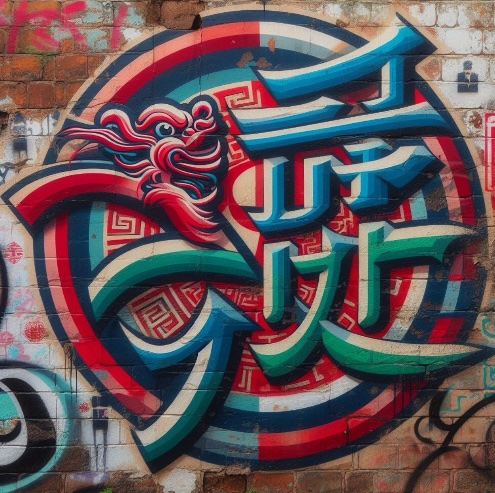AI writes sinoglyphs
« previous post | next post »
From Jeff DeMarco:
A Chinese friend has been experimenting with AI, the result being guǐzi 鬼子 ("ghost characters"). We’ve seen something similar, but the hànzì 汉字 ("sinoglyph") manipulation is almost artistic. Have you encountered this before?
Well, I see a dragon's head in there, appropriate to the season / year. And I notice strokes and components that I'm familiar with from many other characters, so the machine is being truthful to what it was trained on, but I have no idea what it all adds up to.
Selected readings
AI and art
- "Stochastic popinjay and Perso-Arabic art / adab" (1/20/24)
- "AI is producing ‘fake’ Indigenous art trained on real artists’ work without permission: One Indigenous artist said the process of using their art to train AI models that competes with them for work is a ‘very colonial mindset’." Cam Wilson, Crikey (Jan 19, 2024). — just to keep up to date on some other aspects of AI
- "More AI shenanigans" (10/21/23)
- "AI encroachments" (7/21/23)

Jonathan Smith said,
February 25, 2024 @ 3:29 pm
There is a lot of this in OpenAI's Sora demo, see at
https://youtu.be/HK6y8DAPN_0?t=117
https://youtu.be/HK6y8DAPN_0?t=371
(The Tokyo… snow… sakura… prompt is apparently accidentally repeated)
(This demo is also a bit weird in that in significant and consistent ways the system is unable to work to the prompts…)
Jonathan Smith said,
February 25, 2024 @ 3:31 pm
O ya of course also the "Chinese Dragon" new year prompt
https://youtu.be/HK6y8DAPN_0?t=465
AntC said,
February 25, 2024 @ 3:35 pm
I'm no calligrapher, but I'm puzzled what would be the stroke order. I can't see how the strokes would flow within the space — which is supposed to be a square, not a circle?
Is it again a case of AI not 'understanding' anything about the topic area — viz. that you draw with a brush?
Hantolo said,
February 25, 2024 @ 6:59 pm
There are some more similar AI generated graphics and sinoglyphs which would be of interest to you:
https://m.facebook.com/profile.php/?id=61555294846859
Victor Mair said,
February 25, 2024 @ 9:29 pm
@AntC
Also, that you don't mix art into your script.
Whoever trained / taught the AI machine that produced this round "glyph" (????) didn't have much of a clue about how Hànzì 漢字 are constructed and work.
See:
"Rectilinear rectitude" (11/6/23)
https://languagelog.ldc.upenn.edu/nll/?p=61173
"Grids galore" (11/19/23)
https://languagelog.ldc.upenn.edu/nll/?p=61312
Nat said,
February 26, 2024 @ 3:15 am
Am I right in thinking that the right hand side is reminiscent of a Chinese character, while the left hand semi-circle (with attached dragon head) does not even give the impression of characters?
(Apologizes if I'm merely repeating AntC's and Prof. Mair's comments. I take them to be referring to the containing circle, not the smaller semi-circle.)
Nat said,
February 26, 2024 @ 3:41 am
@ Jonathan Smith
in re the weirdness of the demo, on OpenAI's webpage for Sora, they are quite explicit about the failings the videos. It seems that they are soliciting public assistance in developing and improving the technology.
bks said,
February 26, 2024 @ 9:04 am
Similar to the AI-created labels for Figure 2 in the now-famous rat paper:
https://arstechnica.com/science/2024/02/scientists-aghast-at-bizarre-ai-rat-with-huge-genitals-in-peer-reviewed-article/
Dai said,
March 5, 2024 @ 5:07 pm
Ran into this problem trying to create an image for a social media flyer promoting my chengyu 成语 knowledge survey.
https://janet.craft.me/micAE5VxjJF1Ow
In the end had to remove any mention of characters/writing/language from the AI prompt but it often still added a calligraphy-like signature in one corner of the image.
If you squint, some glyphs look like real characters,
e.g. the 且-like glyph, 庙-like glyph and 大-like glyph in the top right dragon image.
Victor Mair said,
March 5, 2024 @ 5:44 pm
@Dai
Wow! Wow! Wow! I'm impressed. They look like sinoglyphs without being actual sinoglyphs. In this sense, I prefer these AI generated glyphs from Canva over Xu Bing's "writings from the sky", which look too much like genuine sinoglyphs. When the first visitors (highly literate) viewed them in Beijing in 1988, Xu Bing's pseudo-sinoglyphs drove them nuts, because the visitors strained hard to recognize them, but couldn't make sense of a single one. In contrast, these AI glyphs from Canva are strongly reminiscent of hanzi, but make no pretense of being genuine hanzi. Rather they bring to their execution a creative flair that is pleasantly stimulating, not disappointing, offputting, puzzling, and frustrating.
Dai said,
March 7, 2024 @ 12:39 am
@ Victor Mair
Yes I don't know much about how AI image generators work but I get the sense that if it iterates random noise with the goal of generating the "best average" of what was asked for, then it won't output actual words/particular glyphs because these are unlikely to be exemplars of the language as a whole. What glyph would we pick as the perfect model of a Chinese character?
But for sure some AI image generators are less uncanny than others, and less uncanny than Xu Bing's Book from the Sky.
If you're curious, the AI image generator also struggles to depict the story/scene of a particular chengyu even with a detailed, descriptive prompt.
Try to guess these four chengyu from the images :)
https://janet.craft.me/micAE5VxjJF1Ow
Also (shameless/desperate plug), I'm seeking L1 Mandarin speakers to complete a 10-minute online chengyu judgement task. Collecting this data for my PhD research.
If you're able to help out or share, this is the link: http://tinyurl.com/3d5mfvru